Add this eBook to your basket to receive access to all 61 records. Our indexes include entries for the spelling parmiter. In the period you have requested, we have the following 61 records (displaying 41 to 50): These sample scans are from the original record. You will get scans of the full pages or articles where the surname you searched for has been found. Your web browser may prevent the sample windows from opening; in this case please change your browser settings to allow pop-up windows from this site. Clergy on the committees of the Anglican Church Congress
(1892)
The 32nd annual congress of the Anglican church was held at Folkestone on the 4th, 5th, 6th and 7th October 1892. Moral and social questions were discussed as well as the purely theological and ecclesiastical - The Relation between the Authority of the Bible and the Authority of the Church; the Attitude of the Church towards Labour Combinations; the Work of the Church of England on the Continent; the Result of the Neglect of Religious Instruction in Elementary Schools; Canon Law; the Duty of the Church to the Agricultural Population; Christian Ethics; Meeting of Women; the Temperance Movement; Physical Recreation; the Permanent Value of the Old Testament; Thrift and the Poor Law; Vivisection; Preparation for Clerical Orders, and of Laymen for Evangelism; Foreign Missions; the Duty of the Church towards Soldiers; Christian Doctrine and Christian Life; Preaching in the Church of England; and the Church's Work at the Seaside. The sermons, letters, addresses and discussions (of clergy and laity) were all published in this, the official report of the congress. The report also included lists of the members of the committees, divided into clergy and laity: this is the index to the clergy. | Sample scan, click to enlarge

| Boys entering Dover College
(1896)
The second edition of the Dover College Register, edited by William Stevens Lee, lists all boys entering the school from its opening in 1871 to the date of publication in 1899. The boys are listed alphabetically by term of entry, surname and full christian names. A double dagger after the name indicates a school prefect. Next comes the year or date of birth, then abbreviations indicating house - [D] day boy; [Sch.] School House; [Sp.] Sparke's House; [St.] Steedman's House; [W.] Walters' from 1881 to 1886, Williams' from 2nd term 1890 to 3rd term 1898; [L.] Littlewood's (the same house as Walters') fom 3rd term 1886 to 1st term 1890. From 3rd term of 1892 onwards the names were changed to [S.] School House; [P.] Priory House (was Sparke's); [M.] St Martin's (was Williams'). Moreover, in January 1893 the Junior School was established at West Mount, and from then onwards [J] indicates a period there. Next come distinctions gained in the school, exhibitions, &c., and athletic distinctions, such as XI for membership of the school cricket eleven, XV for the school football team, with years; then date of leaving; distinctions gained since leaving; and present address (where known) as of 1899. Despite this attempt at comprehensive coverage, the materials to hand for compiling the register were often lacking: at worst, in the early years, there are a handful of entries where only the surname is given. Equally, other entries are detailed and comprehensive. | Sample scan, click to enlarge
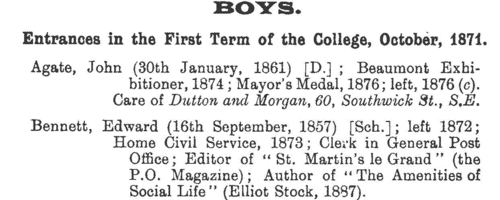
| Boys entering Dover College
(1897)
The second edition of the Dover College Register, edited by William Stevens Lee, lists all boys entering the school from its opening in 1871 to the date of publication in 1899. The boys are listed alphabetically by term of entry, surname and full christian names. A double dagger after the name indicates a school prefect. Next comes the year or date of birth, then abbreviations indicating house - [D] day boy; [Sch.] School House; [Sp.] Sparke's House; [St.] Steedman's House; [W.] Walters' from 1881 to 1886, Williams' from 2nd term 1890 to 3rd term 1898; [L.] Littlewood's (the same house as Walters') fom 3rd term 1886 to 1st term 1890. From 3rd term of 1892 onwards the names were changed to [S.] School House; [P.] Priory House (was Sparke's); [M.] St Martin's (was Williams'). Moreover, in January 1893 the Junior School was established at West Mount, and from then onwards [J] indicates a period there. Next come distinctions gained in the school, exhibitions, &c., and athletic distinctions, such as XI for membership of the school cricket eleven, XV for the school football team, with years; then date of leaving; distinctions gained since leaving; and present address (where known) as of 1899. Despite this attempt at comprehensive coverage, the materials to hand for compiling the register were often lacking: at worst, in the early years, there are a handful of entries where only the surname is given. Equally, other entries are detailed and comprehensive. | Sample scan, click to enlarge
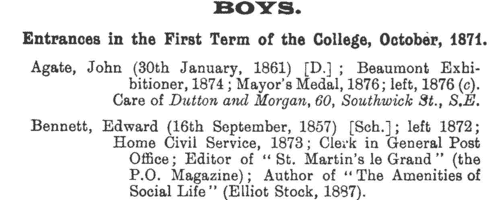
| Women Students Entering Stockwell Teacher Training College
(1897)
This list, revised to August 1908, gives the student's name and her then address (if known); the Remarks column indicates whether she left the course early; left the profession; went abroad; died; became a headmistress; and/or married: married name is often given. | Sample scan, click to enlarge

| Student Members of the Institution of Civil Engineers
(1904)
The Institution of Civil Engineers was established 2 January 1818, and incorporated by royal charter 3 June 1828. The annual report lists the names and addresses (throughout the world) of the four classes of member - members (M. Inst. C. E.), associate members (Assoc. M. Inst. C. E.), associates (Assoc. Inst. C. E.), students (Stud. Inst. C. E.) - with the dates of admission. This is the index to the Students. The symbols at the left of each page are + for contributors of papers published in the Minutes of Proceedings, or of an Engineering Conference Note; F for a deliverer of a James Forrest Lecture; L for a deliverer of one of the Special Series of Lectures; and various letters for recipients of certain medals and prizes - B, Bayliss Prize; C, Crampton Prize; f, James Forrest Medal; H, Howard Quinquennial Prize; J, Joule Medal; M, Miller Scholarship; m, Miller Prize; italic m, Manby Premium; S, George Stephenson Medal or Prize; T, Telford Premium; t, Telford Premium; italic t, Trevithick Premium; and W, Watt Medal. | Sample scan, click to enlarge
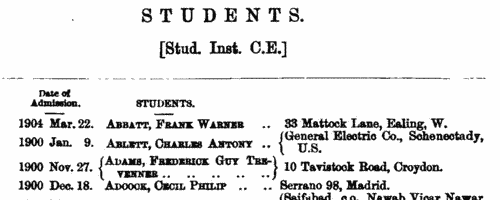
| Medical Practitioners in the Provinces
(1926)
The Medical Directory was split into several sections. The Provinces section covered all medical practitioners resident in England outside the London postal district (except those in Monmouthsire, who were listed under Wales). Each year a schedule was sent to each doctor to be returned to the publishers, so as to keep the directory up to date. In the directory the doctor's name is given first, in bold, surname first, in capitals; then current address. Next are the qualifications; the italic abbreviations in parentheses following the qualifications indicate the medical school at which they were gained. Then there is a list of posts and honours within the profession, starting with those then current; previous posts are preceded by the word 'late'. Finally, brief details are given of any publications. | Sample scan, click to enlarge

| Surgeons
(1928)
The Royal College of Surgeons, established by royal charters, issued this calendar 1 August 1928, including official lists of all its fellows, members, licentiates and diplomates. The register of fellows gives full name (surname first) and address (in italics), with dates of admission as fellow and member. The list of members gives year of admission, full name (surname first) and town or country of residence. The lists of licentiates give year of admission and full name, but no indication of current address: entries of fellows of the college are prefixed with a double dagger, those of members with an asterisk. The lists of diplomates give year of admission and full name (surname first), with those diplomates who were neither members nor fellows of the college indicated with a dagger. This is the index to the members. | Sample scan, click to enlarge
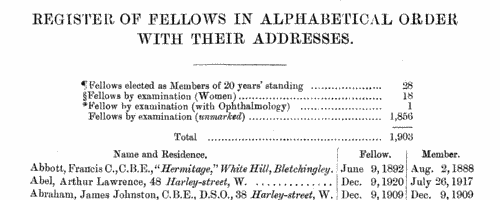
| Anglican clergy
(1930)
Crockford's Clerical Directory listed all Anglican clergy in the British Isles, India, the colonies, Europe, Asia and South America. The 59th annual issue, for 1930, is based on returns from all the individuals listed. The details given are: name (surname first, in capitals) in bold, prefixed by an asterisk in the case of university electors, and by a dagger whether the return had not been made, or it had been imperfectly filled up; name of theological college and/or university, and degrees, with years; a bold d followed by year and diocese signifies date of ordination as deacon and by which bishop; then a bold p, similarly for ordination as priest; posts (C: curate; I: incumbent; V; vicar; R: rector) with parishes and years; address; telephone number; and lists of books &c. where appropriate. In the case of the man then holding an English, Irish, Scottish or Welsh benefice, additional details are given - a bold P signifies the patron of the advowson; then the income, with items such as Q. A. B. (Queen Anne's Bounty), Eccles(iastical) Comm(issioners), Fees, e. o. (Easter Offerings), Pew Rents, T(ithe) R(ent) C(harge), Gl(ebe), &c. | Sample scan, click to enlarge

| Members of Oxford University: Men
(1931)
The Oxford University Calendar for 1931 includes this list of all living members of the university, i. e. not only undergraduates and members of staff, but also all surviving graduates from earlier generations. The names are arranged alphabetically by surname, then by college in order of foundation. Surnames are given, initials, highest degree, name of college, and then the year of graduating the first degree. For undergraduates only name and college is given. An asterisk before a surname indicates a member on the foundation of the college. There are separate lists for men and women. | Sample scan, click to enlarge
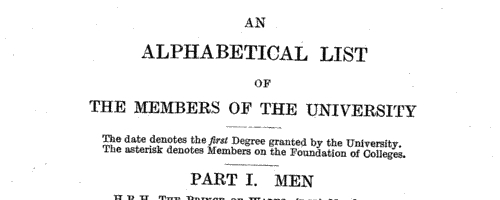
| Residents of Poole, Longfleet and Parkstone
(1934)
Kelly's Directory of Bournemooth, Poole, Parkstone, Etc. includes this list of private residents in Poole, Longfleet and Parkstone (inclusive of Branksome). An asterisk before a name indicates a Parkstone postal address; a dagger, Bournemouth.
| Sample scan, click to enlarge

|
Research your ancestry, family history, genealogy and one-name study by direct access to original records and archives indexed by surname.
|











